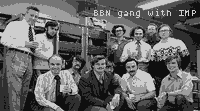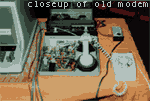 |
|||
 |
|||
![]() Terms
Terms

ALOHAnet - Norm Abramson wanted to surf - so he moved to Hawaii in 1969. Abramson wanted to network with the other islands - so he built the ALOHAnet in 1970. From the University of Hawaii, Abramson connected computers over a network of radio transmitters using a protocol telling the computers how to share the airwaves. more of the story...
ARPAnet - Advanced Research Projects Agency Network. Bob Taylor came up with the idea of networking all the ARPA-funded computers together so he wouldn't have to change seats. more of the story...
Bandwidth - how much stuff you can cram onto the network. A wider bandwidth means more information in a shorter amount of time.

BBN - Bolt, Beranek and Newman, in Cambridge, MA - founded by three partners in the 1950s as a consulting business in acoustic engineering. BBN shifted its business to computers as they became more important. In 1969, BBN was awarded the contract to build the first IMPs. more of the story...
Browser - software for navigating the Web, retrieving documents and other files, and displaying them on the user's screen. Two of the most popular browsers are Netscape Navigator and Microsoft Internet Explorer.
Bulletin Board System (BBS) - the cyberspace equivalent to the office bulletin board, a BBS is software that allows users to post and read messages left by other users. Bulletin Board Systems were very popular in the 1980's when computer enthusiasts set up their own systems on personal computers. more of the story...
Domain Name - When the keepers of the Internet realized that the number of computers on the network was getting too much to handle with simple computer names, they came up with a new addressing system. They added the school, organization, or company name and a domain identifier to tell if it was commercial (com), educational (edu), or something else (org, etc.). The domain for the PBS Web server is "pbs.org" and the full address "www.pbs.org" is the domain name. Other countries have an additional identifier to tell which country it comes from - for example, ".uk" means it's located in the United Kingdom.
Ethernet - a networking technology to connect computers over a local area network invented by Bob Metcalfe and David Boggs at Xerox PARC. Named after the invisible, massless substance that 19th century scientists believed filled the universe. more of the story...
FTP - File Transfer Protocol. One of the first applications developed for the ARPAnet, it's still used to send and retreive files across the Internet.
Graphical User Interface (GUI) - a visual, icon-driven interface for an operating system or other application. A nice litle acronym pronounced "gooey."
Host - Just like a party's host is responsible for all the guests, a computer host takes care of any other computers visiting over a network. In the early days of networking, any computer was a potential host, so now any computer connected to a network is called a host.
HTML - HyperText Markup Language. Publishers have always needed to write down instructions to the printer telling them how they wanted the document to look. Eventually,the printing business developed a standard set of shorthand "markup" instructions or "tags". On the Web, publishers use a Hypertext Markup Language to instruct Web browsers how the document should look. Berners-Lee came up with the first set of HTML tags using a tag style defined by the OSI for their Standard Generalized Makup Language (SGML). The HTML standard is currently defined and controlled by the World Wide Web Consortium.
HTTP - Hypertext Transfer Protocol. This is a set of instructions on how Web browsers and servers talk to each other.
Hypertext - a document formatting that allows documents to be linked by making certain words or phrases "clickable." When the link is followed, the information on the second document is related to the word in the first document. Hypertext is the formatting used on the World Wide Web.

IMP - Interface Messaging Processor - these were the minicomputers that connected each node on the ARPAnet to the network. Built by BBN, each was a refrigerator-sized Honeywell DDP-516 computer with a whopping 12k of memory. more of the story...
Internet - An internet is a group of networks connected together. The Internet (note the capital "I") refers to the global connection of networks around the world.
InterNIC - a collaborative project by Network Solutions, Inc., and AT&T (supported by the NSF) which provides four services to the Internet community. A "white pages" directory of domain names, IP addresses, and publicly accessible databases, domain name and IP address registration, support services for the Internet community, and an online publication summarizing information of interest to the online community.
IP - Internet Protocol, a protocol telling how packets on an internet are addressed and routed. The second part of TCP/IP.
Java - a high-level, object oriented programming language developed by Sun Microsystems that runs on most operating platforms. One of the original purposes of the language was to create a common language for all the "smart" appliances in the house. The ultimate in cross-platform, Java was going to let your TV and toaster speak the same language. Its new mission is to provide a language that programmers can use to write applications anyone can use on any computer. more of the story...
Javascript - A scripting language developed by Netscape Communications to add interactivity to Web pages. It really has little to do with Java, but Javascript is supposed to work across platformas and browsers.
Killer Application - Every step in the development of computers had a special application that made that step work and succeed - a killer app. For the personal computer it was the spread-sheet, and for the Internet it was email.
Local Area Network (LAN) - a group of computers, usually all in the same room or building, connected for the purpose of sharing files, exchanging email, and collaboration.
Mainframe - a large, multiuser computer. Before personal computers were available, businesses and universities purchased large and expensive mainframes and housed them away in large, air-conditioned rooms.
Metcalfe's Law - Metcalfe believes that a network's worth is directly related to the number of people on the networking. In the language of math, his law says "where N is the number of nodes, the power of a network is N squared."

Modem - modulator/demodulator - a device that converts digital (binary) signals from a computer into analog signals suitable for transmission over a phone line. On the other end, another modem it receives analog signals from a phone line and translates the analog signal back into digital bits.
MOSAIC - Soon after Marc Andreessen saw what the new World Wide Web could do in 1992, he thought a graphical interface for the browser would let everyone use the Web. He and seven other student programmers at the University of Illinois wrote the world's frist graphics Web browswer, Mosaic, in 1992. more of the story...
NSFnet - A wide-area network developed by the National Science Foundation (NSF) in 1985. NSFnet replaced ARPAnet as the main government network linking universities and research facilities in 1990.
Node- a processing location on a network.
Packet - to send a message over a packet-switched network, the whole message it first cut up into smaller "packets" and each is numbered and labeled with an address saying where it came from and another saying where its going.
Packet switching - the technology that made large-scale computer networking possible. Instead of a dedicated connection between two computers, messages are divided up into packets and transmitted over a decentralized network. Once all the packets arrive at the destination, they are recompiled into the original message. more of the story...
Protocol - format or set of rules for communication, either over a network or between applications.
Router - a descendent of the IMP, a router directs packets between separate local area networks. To make the connection more efficient, a router reads each packet's header and directs it in the fastest direction. more of the story...
Search Engine - a program accessible on the Web which has a catalog of scanned Web sites in a large database. The user enters a list of keyword or search parameters, and the search engine creates a list of matches for the user to choose from.
TCP/IP - Transmission Control Protocol/Internet Protocol, first defined by Vint Cerf and Bob Kahn in 1973, the protocol made the Internet possible and has become the default network protocol around the world. more of the story...

TELNET - Terminal Emulation. Telnet allows a user at a remote computer to log on to another computer over a network and enter commands at a prompt as if they were directly connected to the remote computer.
Unix - an operating system developed by Kerrighan and Richie at AT&T Bell Labs in the late 1960's. It was written entirely in the C programming language, which made it easier to port to other platforms. It is still the primary operating system for the biggest servers on the Internet.
URL - Uniform Resource Locator, the address of a document or other resource reachable on the Internet. A URL has three components, specifying the protcol, server domain name, and the file location. For example, "http://www.pbs.org/nerds201/index.html" specifies using the HTTP protocol (others include ftp or gopher), on the www.opb.org server, and the file "/nerds201/index.html."
Usenet - A worldwide bulletin board system that can be accessed through the Internet or through many online services. The USENET contains more than 14,000 forums, called newsgroups, that cover almost every imaginable interest group. Created years before the Web, It is still used daily by millions of people around the world.
World Wide Web (WWW) - The protocol devised and implemented by Tim Berners-Lee in 1990 to help researchers at CERN share information across a diverse computer network. more of the story...
Xanadu - a networked, nosequential, hyperlinked system of documents and multimedia objects first proposed by Ted Nelson in 1965. Nelson's system was similar to the World Wide Web, but included the ability to compose documents from sections scattered around the network and a method of making micropayments to copyright holders. more of the story...
Xerox PARC - The Palo Alto Recearch Center was built by Xerox in the early 1970s to keep them ahead of the other office equipment companies in developing the office of the future. It is the location of many of the innovations that have changed the computer and communications. more of the story...
Next Section:
Internet Timeline![]()
Copyright © 1998, PBS Online,
Inc. All Rights Reserved.
Site Designed and Developed by
OPB Learning Media